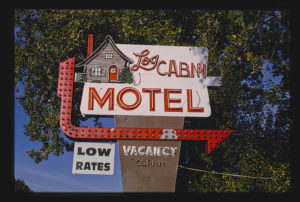Cady Noland had created in 1990 her “Log Cabin Blank With Screw Eyes and Cafe Door” (the Work), made out of wooden logs. It represents the façade of a log cabin, with one open door and two windows, and “[t]wo U.S. flags are an integral part of the sculpture,” according to the July 2017 complaint. The work was created to be displayed outdoors, and after years exposed to the sun and cold of Berlin, the wood used to create the Work had rotted.
Cady Nolan asserted in the 2017 complaint that she “has continuously owned the copyright to the Work. An application for registration of the copyright to Log Cabin together with the required fee and deposit material was transmitted to the Copyright Office in proper form and registration was refused. Plaintiff has complied with the requirements for registration of Log Cabin as provided in 17 U.S.C. § 411(a), and in accordance with said section will be serving notice and a copy of this Complaint on the Register of Copyrights” (my emphasis).
Indeed, the artist had filed an application to register the Work as a sculpture in July 2017, but this was denied the same month, because the work “lacks the authorship necessary to support a copyright claims” and because it “is a useful article… that … does not contain any non-useful design element that could be copyrighted and registered.”

Log Cabin or Conceptual Art?
In December 2017, Noland requested the Review Board of the United States Copyright Office (the Board) to reconsider the Registration Program’s refusal to register her work a second and final time, claiming that the work was original enough to be protected by copyright, and arguing she had made creative choices in order for the work to embody her idea to “construct the front of a house… to showcase the failed promise of the American dream” and that “the selection, arrangement, and combination of elements present in [the] work clearly meet the threshold of creativity required for a work to obtain copyright protection.”
Why is Log Cabin not original enough to be protected by copyright?
Conceptual art and copyright
“recognizing copyright in Wildflower Works presses too hard on these basic principles. We fully accept that the artistic community might classify Kelley’s garden as a work of postmodern conceptual art. We acknowledge as well that copyright’s prerequisites of authorship and fixation are broadly defined. But the law must have some limits; not all conceptual art may be copyrighted.”… A garden’s constituent elements are alive and inherently changeable, not fixed. Most of what we see and experience in a garden — the colors, shapes, textures, and scents of the plants — originates in nature, not in the mind of the gardener.”



